Fiber Coupled High Power Nd:YAG Laser for Nondestructive Laser Cleaning
Abstract
:1. Introduction
2. Experimental Setup
Laser Resonator and Amplifier System Configuration
3. Theoretical Analysis of Laser Resonator
4. Results and Discussion
4.1. Laser Performance of the LD Side-Pumped AO Q-Switched Nd:YAG Laser System
4.2. Comparison of Thermal Control Coating Removal between Nd:YAG and Fiber Laser Cleaning Machine
5. Conclusions
Author Contributions
Funding
Institutional Review Board Statement
Informed Consent Statement
Data Availability Statement
Conflicts of Interest
References
- Madhukar, Y.K.; Mullick, S.; Shukla, D.K.; Kumar, S.; Nath, A.K. Effect of laser operating mode in paint removal with a fiber laser. Appl. Surf. Sci. 2013, 264, 892–901. [Google Scholar] [CrossRef]
- Zhu, G.D.; Xu, Z.H.; Jin, Y.; Chen, X.; Yang, L.J.; Xu, J.; Shan, D.B.; Chen, Y.B.; Guo, B. Mechanism and application of laser cleaning: A review. Opt. Laser. Eng. 2022, 157, 107130. [Google Scholar] [CrossRef]
- Razab, M.; Noor, A.M.; Jaafar, M.S.; Abdullah, N.H.; Suhaimi, F.M.; Mohamed, M.; Adam, N.; Yusuf, N. A review of incorporating Nd:YAG laser cleaning principal in automotive industry. J. Radiat. Res. Appl. Sci. 2018, 11, 393–402. [Google Scholar] [CrossRef] [Green Version]
- Chen, T.; Wang, W.J.; Tao, T.; Pan, A.F.; Mei, X.S. Multi-scale micro-nano structures prepared by laser cleaning assisted laser ablation for broadband ultralow reflectivity silicon surfaces in ambient air. Appl. Surf. Sci. 2020, 509, 145182. [Google Scholar] [CrossRef]
- Li, W.Q.; Su, X.; Gu, J.Y.; Jin, Y.; Xu, J.; Guo, B. Removal Mechanisms and Microstructure Characteristics of Laser Paint Stripping on Aircraft Skin Surface. Photonics 2023, 10, 96. [Google Scholar] [CrossRef]
- Gao, K.; Xu, J.J.; Zhu, Y.; Zhang, Z.Y.; Zeng, Q.S. Study on the Technology and Mechanism of Cleaning Architectural Aluminum Formwork for Concrete Pouring by High Energy and High Repetition Frequency Pulsed Laser. Photonics 2023, 10, 242. [Google Scholar] [CrossRef]
- Fang, C.H.; Hu, T.; Pu, Z.H.; Li, P.; Wu, T.; Jiang, J.B.; Sun, A.Q.; Zhang, Y. Effect of Laser Cleaning Parameters on Surface Filth Removal of Porcelain Insulator. Photonics 2023, 10, 269. [Google Scholar] [CrossRef]
- Yue, L.Y.; Wang, Z.B.; Li, L. Modeling and simulation of laser cleaning of tapered micro-slots with different temporal pulses. Opt. Laser Technol. 2013, 45, 533–539. [Google Scholar] [CrossRef]
- Shi, T.Y.; Wang, C.M.; Mi, G.Y.; Yan, F. A study of microstructure and mechanical properties of aluminum alloy using laser cleaning. J. Manuf. Process. 2019, 42, 60–66. [Google Scholar] [CrossRef]
- Tian, Z.; Lei, Z.L.; Chen, Y.B.; Chen, C.; Zhang, R.C.; Chen, X.; Bi, J.; Sun, H.R. Inhibition Effectiveness of Laser-Cleaned Nanostructured Aluminum Alloys to Sulfate-reducing Bacteria Based on Superwetting and Ultraslippery Surfaces. ACS Appl. Bio Mater. 2020, 3, 6131–6144. [Google Scholar] [CrossRef]
- Wei, P.Y.; Chen, Z.H.; Wang, D.; Zhang, R.N.; Li, X.Y.; Zhang, F.; Sun, K.L.; Lei, Y.C. Effect of laser cleaning on mechanical properties of laser lap welded joint of SUS310S stainless steel and 6061 aluminum alloy. Mater. Lett 2021, 291, 129549. [Google Scholar] [CrossRef]
- Wazen, P. 80 W average power of Q-switched ND:YAG laser with optical fibre beam delivery for laser cleaning application. J. Cult. Herit. 2000, 1, S125–S128. [Google Scholar] [CrossRef]
- Choubey, A.; Vishwakarma, S.C.; Vachhani, D.M.; Singh, R.; Misra, P.; Jain, R.K.; Arya, R.; Upadhyaya, B.N.; Oak, S.M. Study and development of 22 kW peak power fiber coupled short pulse Nd:YAG laser for cleaning applications. Opt. Laser. Eng. 2014, 62, 69–79. [Google Scholar] [CrossRef]
- Ouyang, D.Q.; Chen, Y.W.; Liu, M.Q.; Wu, X.; Yang, Q.G.; Xu, F.H.; Zhong, M.R.; Lue, Q.T.; Ruan, S.C. 310 W picosecond laser based on Nd:YVO4 and Nd:YAG rod amplifiers. Opt. Laser Technol. 2022, 148, 107668. [Google Scholar] [CrossRef]
- Furuta, K.; Kojima, T.; Fujikawa, S.; Nishimae, J. Diode-pumped 1 kW Q-switched Nd: YAG rod laser with high peak power and high beam quality. Appl. Opt. 2005, 44, 4119–4122. [Google Scholar] [CrossRef] [Green Version]
- Nicklaus, K.; Hoefer, M.; Hoffmann, D.; Luttmann, J.; Wester, R.; Poprawe, R. MOPA with kW average power and multi MW peak power: Experimental results, theoretical modeling and scaling limits. Solid State Lasers XV Technol. Devices 2006, 6100, 610016. [Google Scholar]
- Wang, Y.B.; Zhang, Z.Y.; Liang, H.; Qu, S.C.; Gao, J.C.; Lin, X.C. Fiber coupled 1 kW repetitively acousto-optic Q-switched cw-pumped Nd:YAG rod laser. Opt. Laser Technol. 2019, 116, 139–143. [Google Scholar] [CrossRef]
- Yang, D.W.; Wang, Y.; Ren, Y. Fiber-coupled high-power diode-pumped solid-state lasers for laser cleaning. Solid State Lasers XXIX Technol. Devices 2020, 11259, 112590T. [Google Scholar]
- Guo, L.; Yang, Y.L.; Xu, H.P.; Kong, H.; Lv, G.R.; Wen, J.Q.; Bian, J.T.; Ye, Q.; Sun, X.Q.; Yang, K.J. High power linearly polarized diode-side-pumped Nd:YAG laser based on an asymmetric flat-flat resonator with the variable working point. Opt. Commun. 2022, 520, 128453. [Google Scholar] [CrossRef]
- Liu, H.Y.; Bian, Q.; Bo, Y.; Zong, N.; Peng, Q.J. Compact 200 W level linearly polarized microsecond-pulse Nd:YAG oscillator with nearly diffraction-limited beam quality. Appl. Opt. 2022, 61, 5614–5618. [Google Scholar] [CrossRef]
- Palomar, T.; Oujja, M.; Llorente, I.; Barat, B.R.; Canamares, M.V.; Cano, E.; Castillejo, M. Evaluation of laser cleaning for the restoration of tarnished silver artifacts. Appl. Surf. Sci. 2016, 387, 118–127. [Google Scholar] [CrossRef] [Green Version]
- Zhu, G.D.; Wang, S.R.; Cheng, W.; Wang, G.Q.; Liu, W.T.; Ren, Y. Investigation on the Surface Properties of 5A12 Aluminum Alloy after Nd: YAG Laser Cleaning. Coatings 2019, 9, 578. [Google Scholar] [CrossRef] [Green Version]
- Ren, Y.; Wang, L.M.; Li, J.F.; Cheng, W.; Ma, X.Q. The Surface Properties of an Aviation Aluminum Alloy after Laser Cleaning. Coatings 2022, 12, 273. [Google Scholar] [CrossRef]
- Ren, Y.; Wang, L.M.; Ma, M.L.; Cheng, W.; Li, B.L.; Lou, Y.X.; Li, J.F.; Ma, X.Q. Stepwise Removal Process Analysis Based on Layered Corrosion Oxides. Materials 2022, 15, 7559. [Google Scholar] [CrossRef]
- Afifi, H.A.M.; Abdel-Ghani, M.; Mahmoud, R.; Alkallas, F.H.; Trabelsi, A.B.G.; Mostafa, A.M. Comparative Study between First and Second Harmonics of a Nd:YAG Laser for Cleaning Manifestation Damages That Appeared in Pigments Used on Archaeological Cartonnage. Micromachines 2023, 14, 1415. [Google Scholar] [CrossRef]
- Hodson, N.; Weber, H. Optical Resonators: Fundamentals; Springer: Berlin/Heidelberg, Germany, 1997; pp. 423–494. [Google Scholar]
- Yuan, X.D.; Zhang, L.; Hu, Z.G.; Liu, Y.N.; Zhang, Z.Y.; Yu, H.J.; Wu, P.; Wang, L.R.; Zhao, W.F.; Wang, Y.B.; et al. High power fiber-coupled acousto-optically Q-switched 532 nm laser with a side-pumped Nd:YAG laser module. J. Opt. Technol. 2017, 84, 373–376. [Google Scholar] [CrossRef]
- Wang, Y.B.; Zhang, Z.Y.; Liang, H.; Gao, J.C.; Qu, S.C.; Lin, X.C. Exploration on hold-off capacity of high power repetitively acousto-optic Q-switched Nd:YAG rod laser. Optik 2019, 185, 161–167. [Google Scholar] [CrossRef]
- Singh, A.; Sharma, S.K.; Mukhopadhyay, P.K.; Bindra, K.S. 260 W of average green beam generation by intracavity frequency-doubled acousto-optic Q-Switched Nd:YAG laser. J. Opt.-India 2019, 48, 512–519. [Google Scholar] [CrossRef]
- Li, Y.G.; Yuan, Z.G.; Wang, J.; Xu, Q. Laser-induced damage characteristics in fused silica surface due to mechanical and chemical defects during manufacturing processes. Opt. Laser Technol. 2017, 91, 149–158. [Google Scholar] [CrossRef]

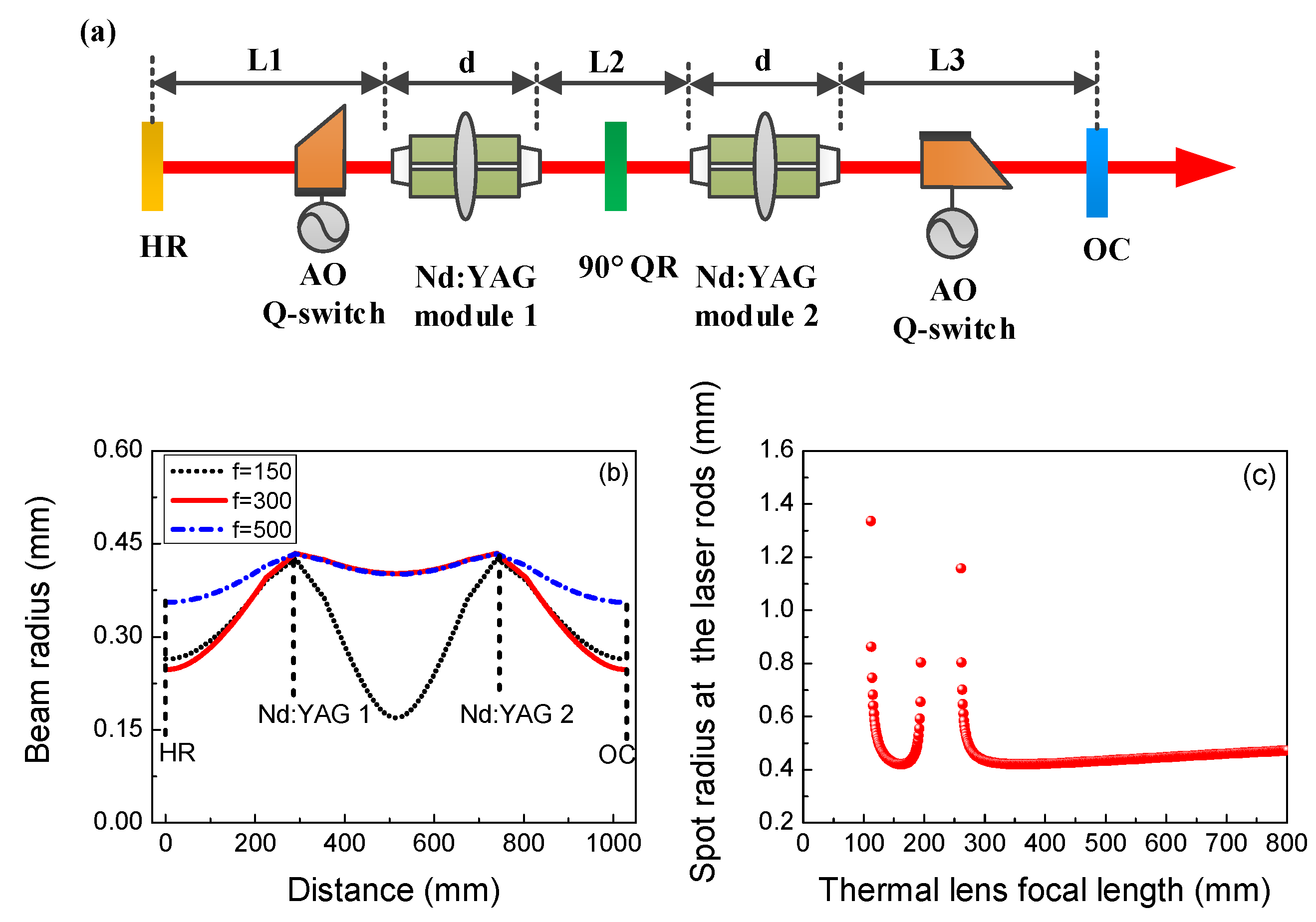
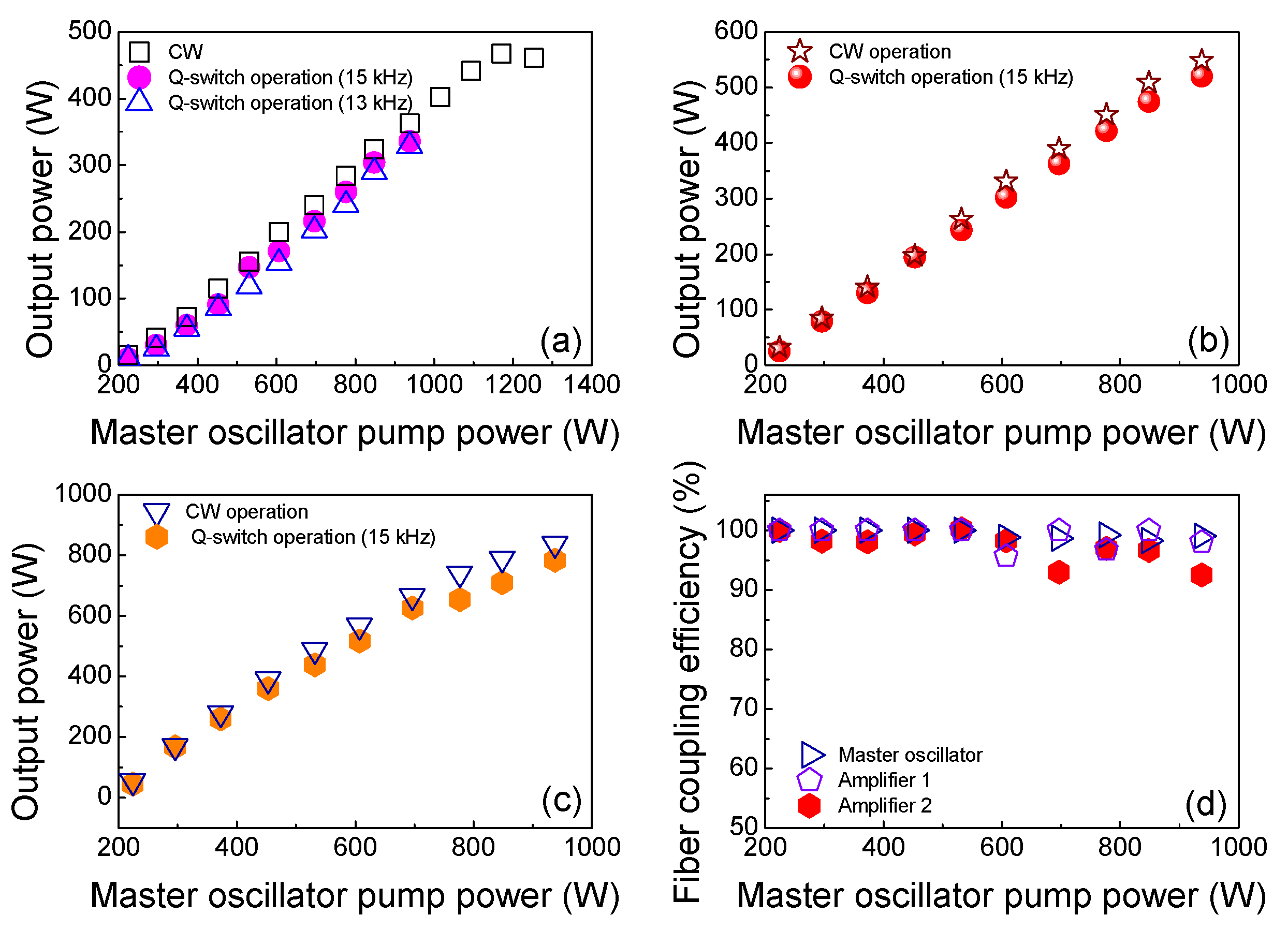
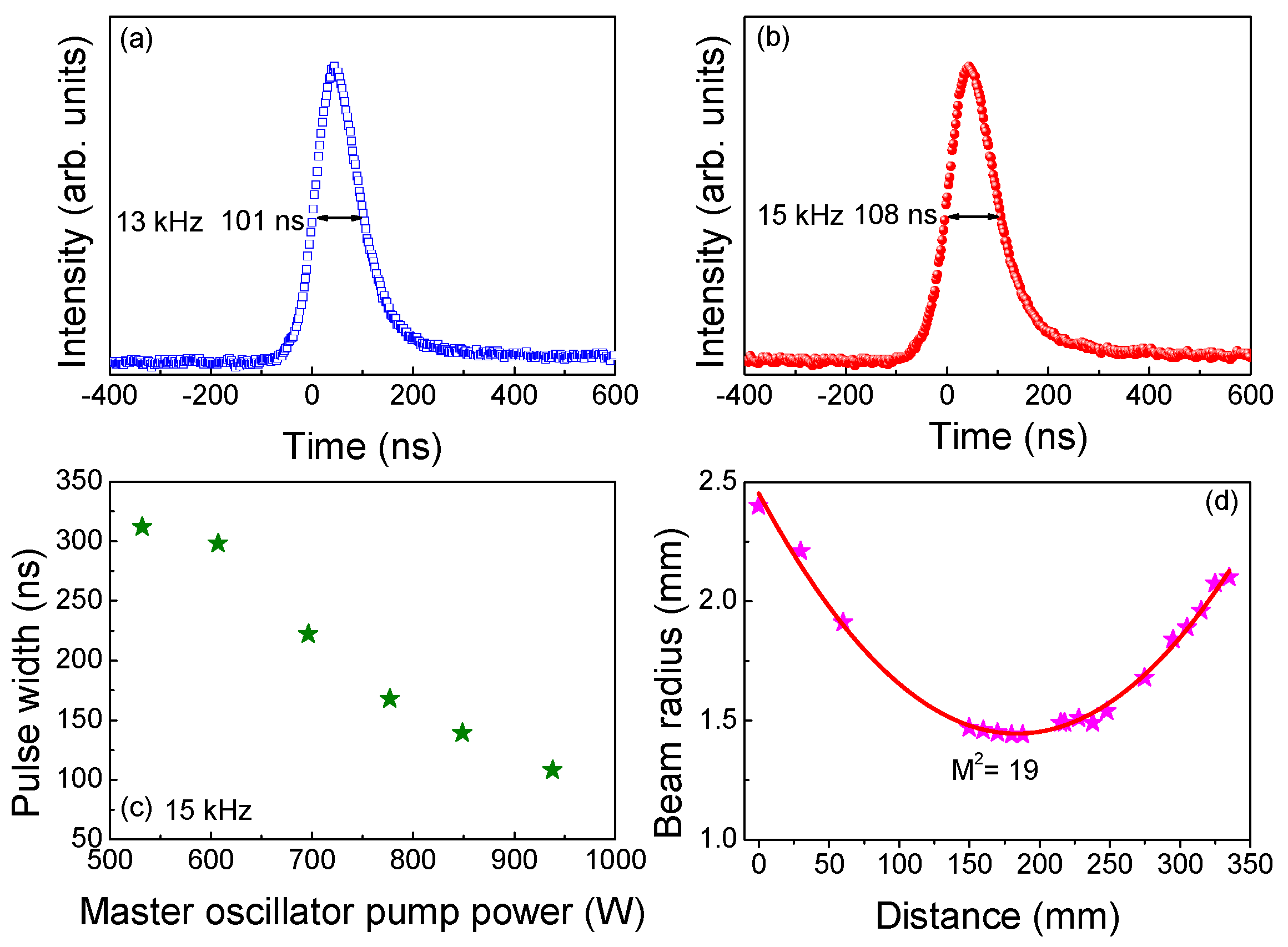
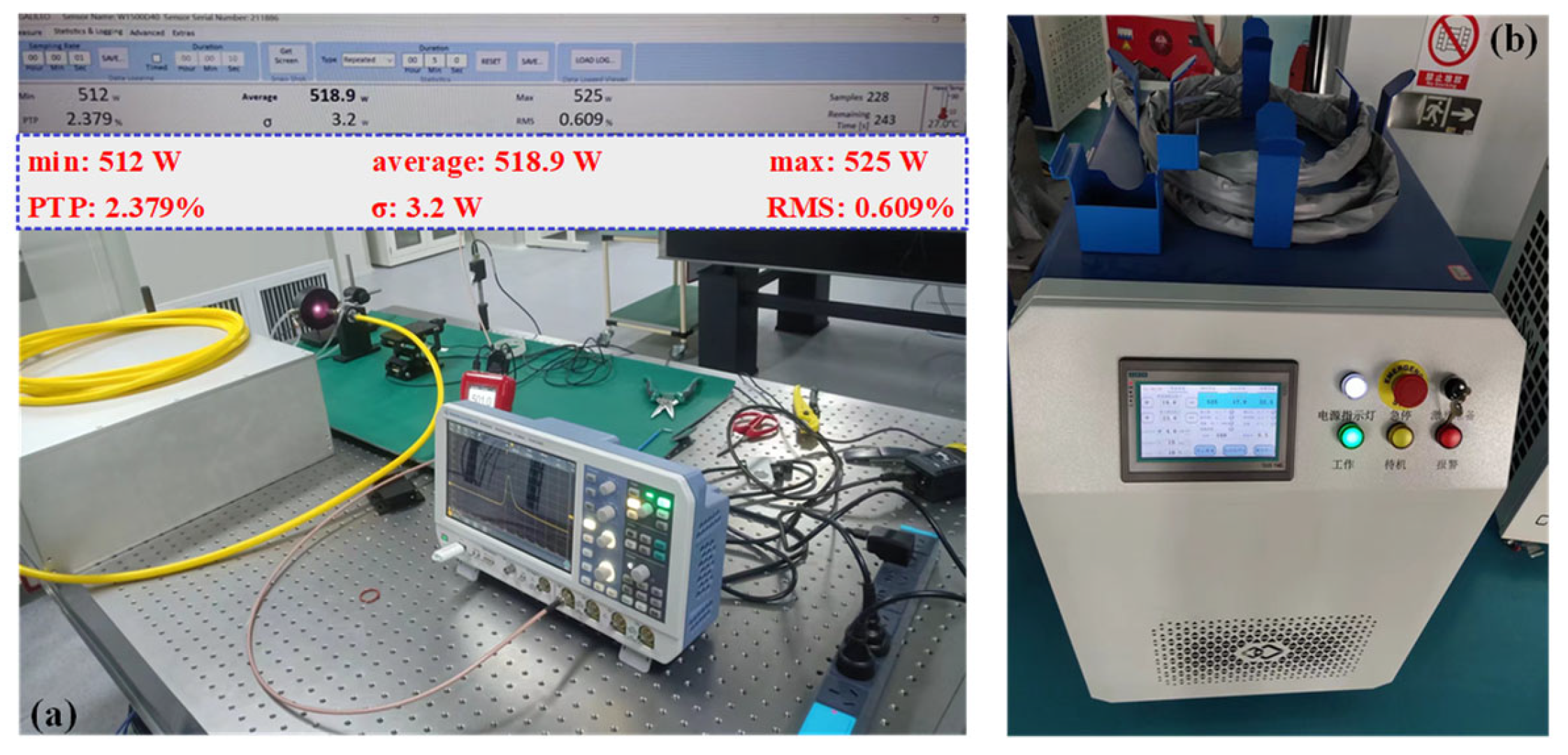

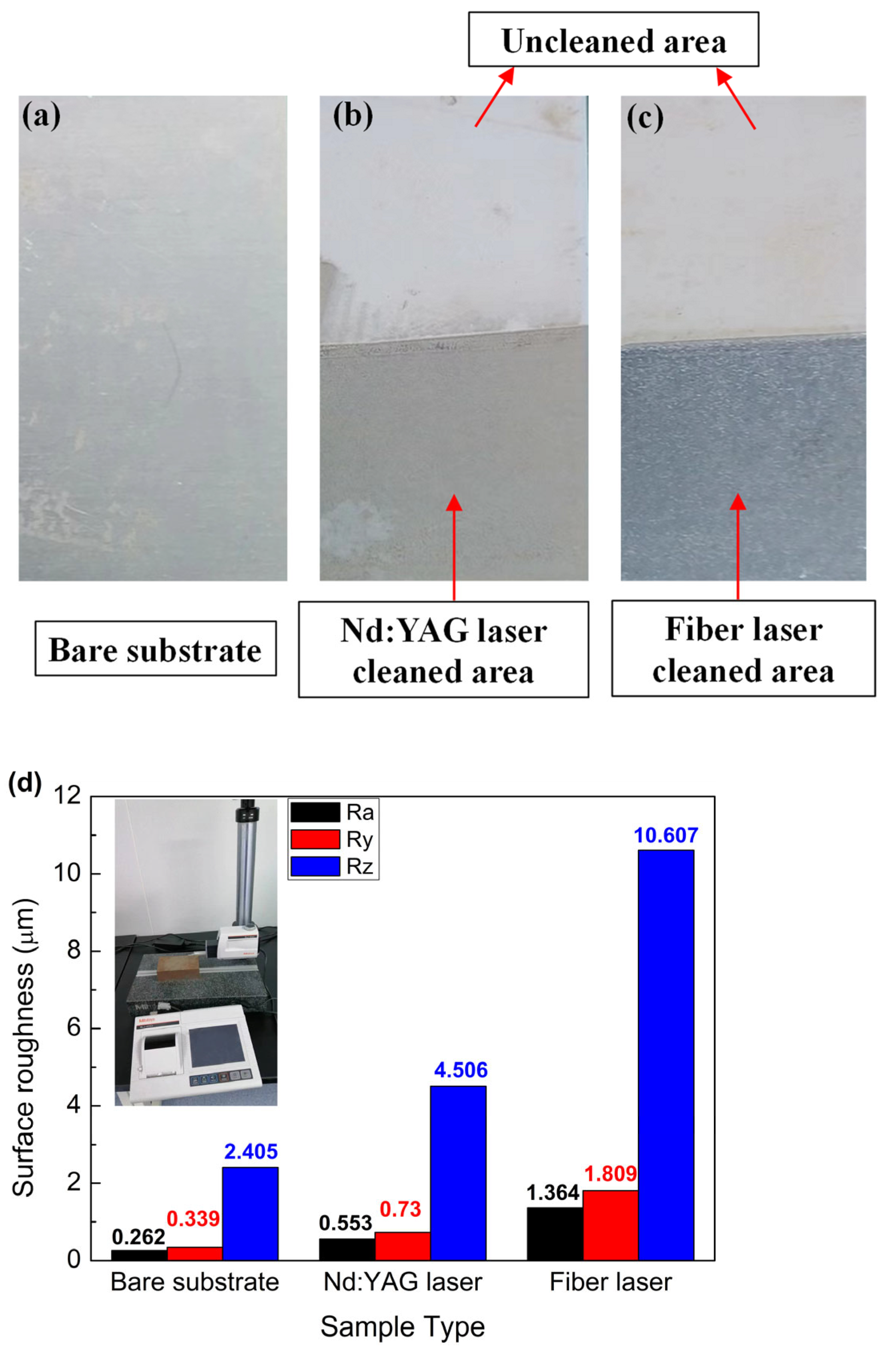
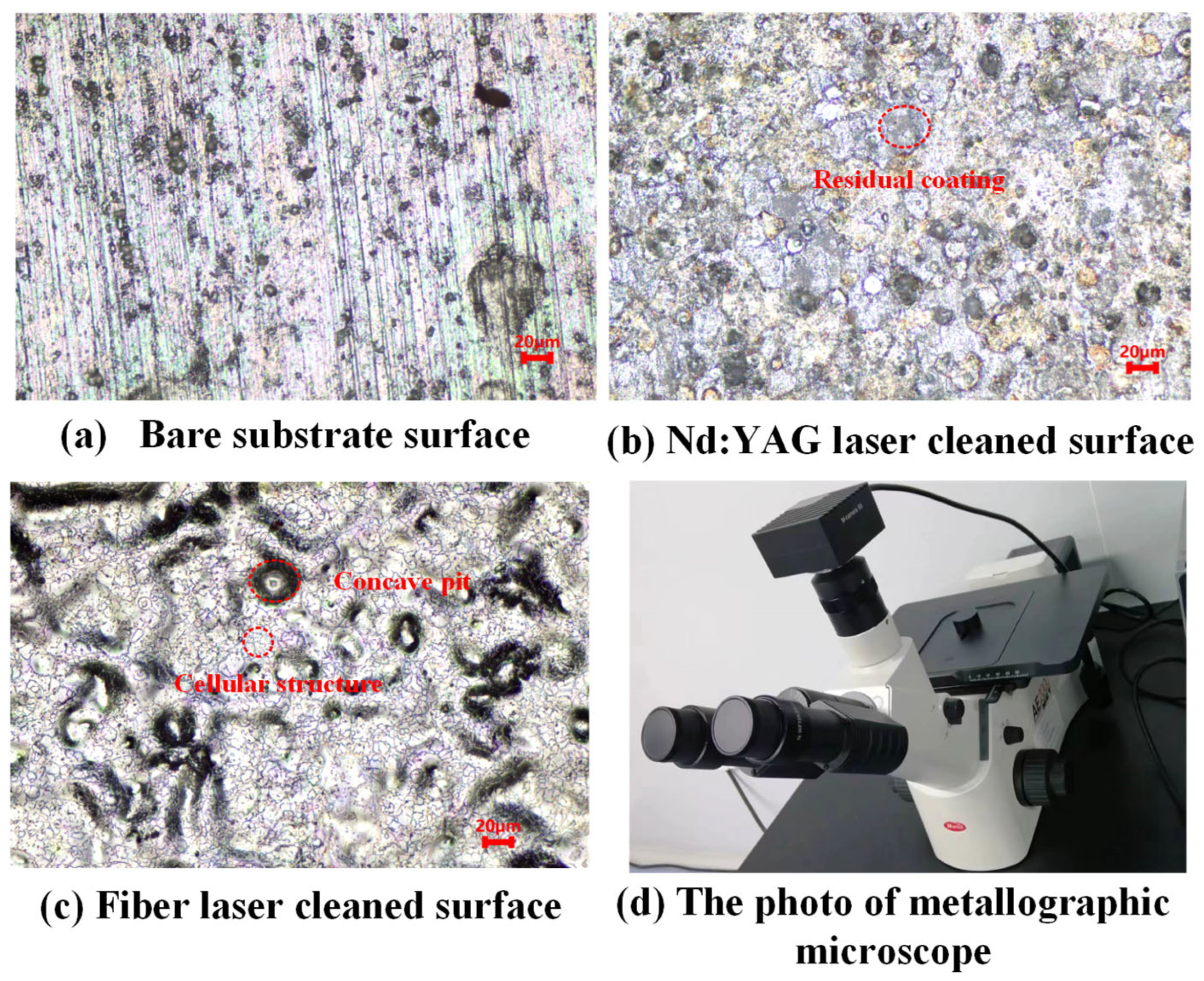
| Laser | λ (nm) | Pav (W) | R. R (kHz) | Ep (mJ) | Pp (kW) | tp (ns) | M2 | ηf (%) | Ref. |
|---|---|---|---|---|---|---|---|---|---|
| Nd:YAG/AO | 1064 | 783 | 15 | 52.2 | 483 | 108 | 19 | 94 | This work |
| Nd:YAG/AO | 1064 | 447 | 10 | 44.7 | 588 | 76 | 22 | [18] | |
| Nd:YAG/AO | 1064 | 1022 | 20 | 51.1 | 500 | 102 | 35.4 | 82–92 | [17] |
| Nd:YAG/AO/LBO | 532 | 165 | 20 | 8.25 | 51.6 | 160 | 90.3% | [27] | |
| Nd:YAG/AO | 1064 | 408 | 15 | 27.2 | 344 | 79 | 24.6 | [28] | |
| Nd:YAG/AO/LBO | 532 | 260 | 18 | 14.4 | 198 | 73 | 35 | [29] |
| Type of Laser | λ (nm) | Dcorre (μm) | Pave (W) | R. R (kHz) | Ep (mJ) | tp (ns) | Pp (kW) |
|---|---|---|---|---|---|---|---|
| Nd:YAG laser | 1064 | 400 | 500 | 15 | 33.3 | 108 | 308 |
| Fiber laser | 1070 | 200 | 500 | 11 | 45.5 | 500 | 91 |
Disclaimer/Publisher’s Note: The statements, opinions and data contained in all publications are solely those of the individual author(s) and contributor(s) and not of MDPI and/or the editor(s). MDPI and/or the editor(s) disclaim responsibility for any injury to people or property resulting from any ideas, methods, instructions or products referred to in the content. |
© 2023 by the authors. Licensee MDPI, Basel, Switzerland. This article is an open access article distributed under the terms and conditions of the Creative Commons Attribution (CC BY) license (https://creativecommons.org/licenses/by/4.0/).
Share and Cite
Wang, X.; Ma, X.; Ren, Y.; Wang, J.; Cheng, W. Fiber Coupled High Power Nd:YAG Laser for Nondestructive Laser Cleaning. Photonics 2023, 10, 901. https://doi.org/10.3390/photonics10080901
Wang X, Ma X, Ren Y, Wang J, Cheng W. Fiber Coupled High Power Nd:YAG Laser for Nondestructive Laser Cleaning. Photonics. 2023; 10(8):901. https://doi.org/10.3390/photonics10080901
Chicago/Turabian StyleWang, Xiaolei, Xinqiang Ma, Yuan Ren, Jingwen Wang, and Wei Cheng. 2023. "Fiber Coupled High Power Nd:YAG Laser for Nondestructive Laser Cleaning" Photonics 10, no. 8: 901. https://doi.org/10.3390/photonics10080901
APA StyleWang, X., Ma, X., Ren, Y., Wang, J., & Cheng, W. (2023). Fiber Coupled High Power Nd:YAG Laser for Nondestructive Laser Cleaning. Photonics, 10(8), 901. https://doi.org/10.3390/photonics10080901





